Say no to authoritarianism, say yes to socialism. Free Palestine 🇵🇸 Everyone deserves Human Rights
- 7 Posts
- 73 Comments

 1·18 hours ago
1·18 hours agoYeah, FPTP is inherently undemocratic and naturally trends to a two-party system. Especially when both parties operate within neoliberalism, intentionally racheting American politics to the right at the behest of capital interests.
I’m all for approval or STAR voting, but I will support any ranked choice ballot measure as any are better than FPTP. Right now it’s only possible to enact new voting systems at a local level

 1·2 days ago
1·2 days agoThat’s a great analysis. Do you have any books or articles to share on the subject?

 7·2 days ago
7·2 days agoHave you stopped posting misinformation? No? Why would the evidence to debunk them change? I’ve already spent plenty of hours aggregating sources to debunk them and they are just as relevant whenever you or anyone else posts the same kind of disinformation.

 8·2 days ago
8·2 days agoI believe everybody deserves to live a comfortable life. I hate seeing disinformation or bigotry that’s used to justify the extermination of a people or normalize their lives under generations of occupation and Apartheid.
Palestinians have been a people for thousands of years. Recent Palestinian Nationalism is an anti-colonialist movement. They were not an explicit nation-state because there was no need before. That in no way justifies ethnic cleansing. If you want the full story, this book covers the four thousand years of history.
First documented in the late Bronze Age, about 3200 years ago, the name Palestine, is the conventional name used between 450 BC and 1948 AD to describe a geographic region between the Mediterranean Sea and the Jordan River and various adjoining lands. This work explores the evolution of the concept, histories, identity, languages and cultures of Palestine from the Late Bronze Age to the modern era.
Moreover, Palestine history is often taught in the West as a history of a land, not as Palestinian history or a history of a people. This book challenges colonial approach to Palestine and the pernicious myth of a land without a people (Masalha 1992, 1997) and argues for reading the history of Palestine with the eyes of the indigenous people of Palestine.
The Palestinians are the indigenous people of Palestine; their local roots are deeply embedded in the soil of Palestine and their autochthonous identity and historical heritage long preceded the emergence of a local Palestinian nascent national movement in the late Ottoman period and the advent of Zionist settler-colonialism before the First World War
- Palestine: A Four Thousand Year History - Nur Masalha

 15·2 days ago
15·2 days agoThe fact that they were living there, as their families have been for generations and generations. What gives Zionists the right to ethnically cleanse and forcibly displace them from their homes?

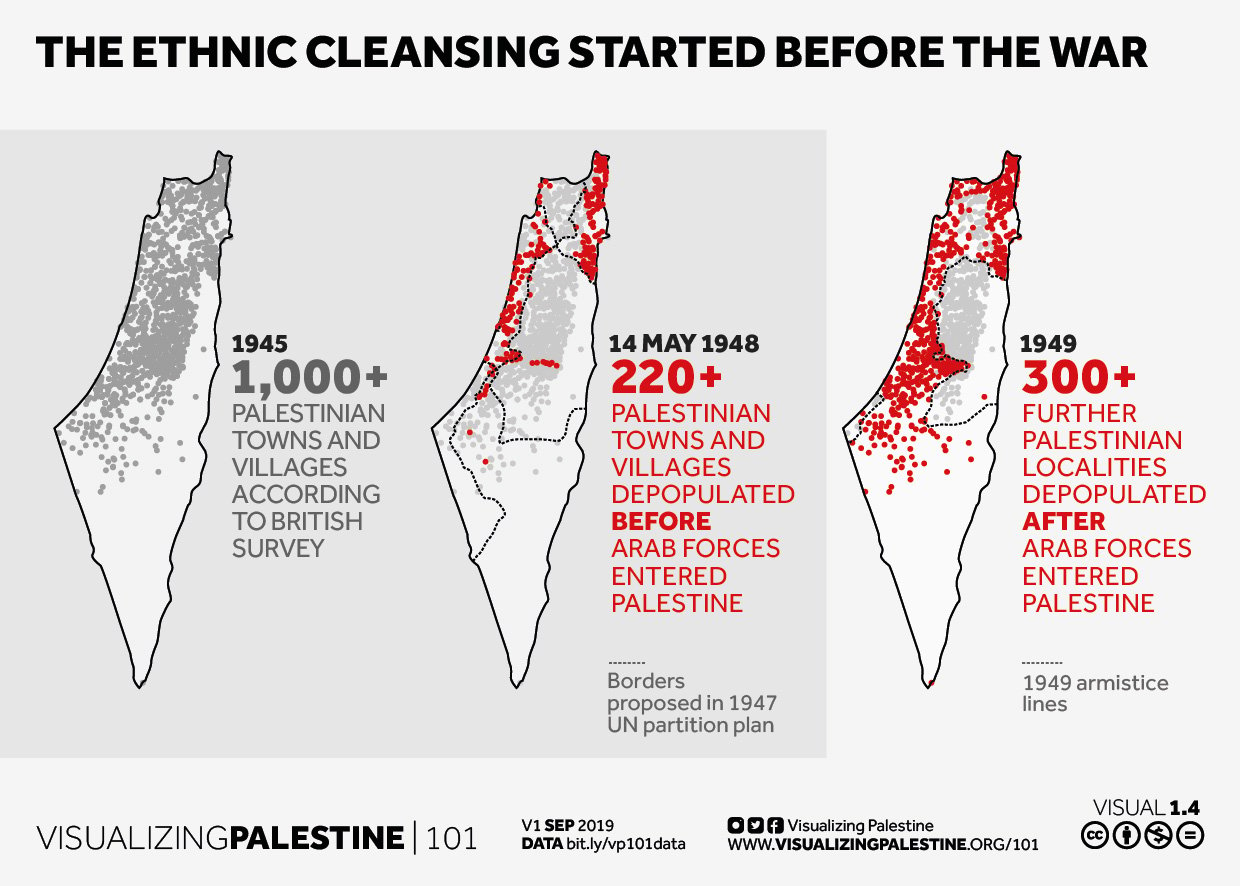


 9·2 days ago
9·2 days agoI feel like we need to normalize that demanding more from representatives is OK and necessary for a functioning democracy. The party needs to respond to the demands of those they are supposed to represent. This election made it clear that they only care about the demands of the donors and that needs to change

 7·2 days ago
7·2 days agoIsrael’s occupation and Blockade has been throttling the food available to Palestinians in Gaza to below what’s needed for decades. The full blockade and famine is simply an extension of a longstanding practice.
“I have ordered a complete siege on the Gaza Strip. There will be no electricity, no food, no fuel, everything is closed,” “We are fighting human animals and we are acting accordingly”
- Yoav Gallant, Minister of Defense
One of the over 500 instances of Israeli incitement of genocide
Israel also arbitrarily limits how far Palestinians can fish in the sea and shoot them on sight. Gaza fisherfolk can only ‘dream of fishing freely’ under Israel’s blockade
De-development via the Gaza Occupation
Between July 1971 and February 1972, Sharon enjoyed considerable success. During this time, the entire Strip (apart from the Rafah area) was sealed off by a ring of security fences 53 miles in length, with few entrypoints. Today, their effects live on: there are only three points of entry to Gaza—Erez, Nahal Oz, and Rafah.
Perhaps the most dramatic and painful aspect of Sharon’s campaign was the widening of roads in the refugee camps to facilitate military access. Israel built nearly 200 miles of security roads and destroyed thousands of refugee dwellings as part of the widening process.’ In August 1971, for example, the Israeli army destroyed 7,729 rooms (approximately 2,000 houses) in three vola- tile camps, displacing 15,855 refugees: 7,217 from Jabalya, 4,836 from Shati, and 3,802 from Rafah.
- Page 105
Through 1993 Israel imposed a one-way system of tariffs and duties on the importation of goods through its borders; leaving Israel for Gaza, however, no tariffs or other regulations applied. Thus, for Israeli exports to Gaza, the Strip was treated as part of Israel; but for Gazan exports to Israel, the Strip was treated as a foreign entity subject to various “non-tariff barriers.” This placed Israel at a distinct advantage for trading and limited Gaza’s access to Israeli and foreign markets. Gazans had no recourse against such policies, being totally unable to protect themselves with tariffs or exchange rate controls. Thus, they had to pay more for highly protected Israeli products than they would if they had some control over their own economy. Such policies deprived the occupied territories of significant customs revenue, estimated at $118-$176 million in 1986.
- page 240
In a report released in May 2015, the World Bank revealed that as a result of Israel’s blockade and OPE, Gaza’s manufacturing sector shrank by as much as 60% over eight years while real per capita income is 31 percent lower than it was 20 years ago. The report also stated that the blockade alone is responsible for a 50% decrease in Gaza’s GDP since 2007. Furthermore, OPE (combined with the tunnel closure) exacerbated an already grave situation by reducing Gaza’s economy by an additional $460 million.
-
Page 402
-
The Gaza Strip: The Political Economy of De-Development - Third Edition by Sara M. Roy
Blockade, including Aid
Hamas began twenty years into the occupation during the first Intifada, with the goal of ending the occupation. Collective punishment has been a deliberate Israeli tactic for decades with the Dahiya doctrine. Violence such as suicide bombings and rockets escalated in response to Israeli enforcement of the occupation and apartheid.
After the ‘disengagement’ in 2007, this turned into a full blockade; where Israel has had control over the airspace, borders, and sea. Under the guise of ‘dual-use’ Israel has restricted food, allocating a minimum supply leading to over half of Gaza being food insecure; construction materials, medical supplies, and other basic necessities have also been restricted.
The blockade and Israel’s repeated military offensives have had a heavy toll on Gaza’s essential infrastructure and further debilitated its health system and economy, leaving the area in a state of perpetual humanitarian crisis. Indeed, Israel’s collective punishment of Gaza’s civilian population, the majority of whom are children, has created conditions inimical to human life due to shortages of housing, potable water and electricity, and lack of access to essential medicines and medical care, food, educational equipment and building materials.
- Amnesty International Report pg 26-27

 10·2 days ago
10·2 days agoA two state solution is impossible due to the settlements in the West Bank. Only a One-State Solution with equal rights for both Israelis and Palestinians is possible now
Netanyahu is the one who has explicitly said that ‘from the river to the sea there shall be only Israeli sovereignty’. A direct reference to the ethnic cleansing of all Palestinians.

Peace Process and Solution
Both Hamas and Fatah have agreed to a Two-State solution based on the 1967 borders for decades. Oslo and Camp David were used by Israel to continue settlements in the West Bank and maintain an Apartheid, while preventing any actual Two-State solution
How Avi Shlaim moved from two-state solution to one-state solution
‘One state is a game changer’: A conversation with Ilan Pappe

 221·2 days ago
221·2 days agoThe resolution that was put to a vote “demands an immediate, unconditional and permanent cease-fire to be respected by all parties, and further reiterates its demand for the immediate and unconditional release of all hostages.”
The release of all the hostages has always been a part of the ceasefire negotiations, that has never changed. Hamas proposed a full prisoner swap as early as Oct 8th, and agreed to the US proposed UN Permanent Ceasefire Resolution. Additionally, Hamas has already agreed to no longer govern the Gaza Strip, as long as Palestinians receive liberation and a unified government can take place.
We’ve had mixed reports of treatment of Israeli hostages by Hamas (1, 2, 3) We know of at least one instance of sexual assault and rape, multiple accounts of abuse, how widespread it is we won’t know until all the hostages are released, which Israel has been preventing.
Israel does torture, rape, and kill Palestinians (including children), and has been for decades.
Palestinian Prisoners in Israeli Prisons
Palestinians are jailed without charge, forced into false confessions, routinely tortured, raped, denied medical attention, and some killed as a result. This includes hundreds of children.
Palestinians denied civil rights (HRW) including Military Court (B’TSelem)
Palestinian Prisoners in Israel (wiki)
Children are jailed and abused in Israeli prisons (Save The Children)
Torture and Abuse in Interrogations (B’TSelem)
Thousands of Palestinians are held without charge under Israeli detention policy (NPR)
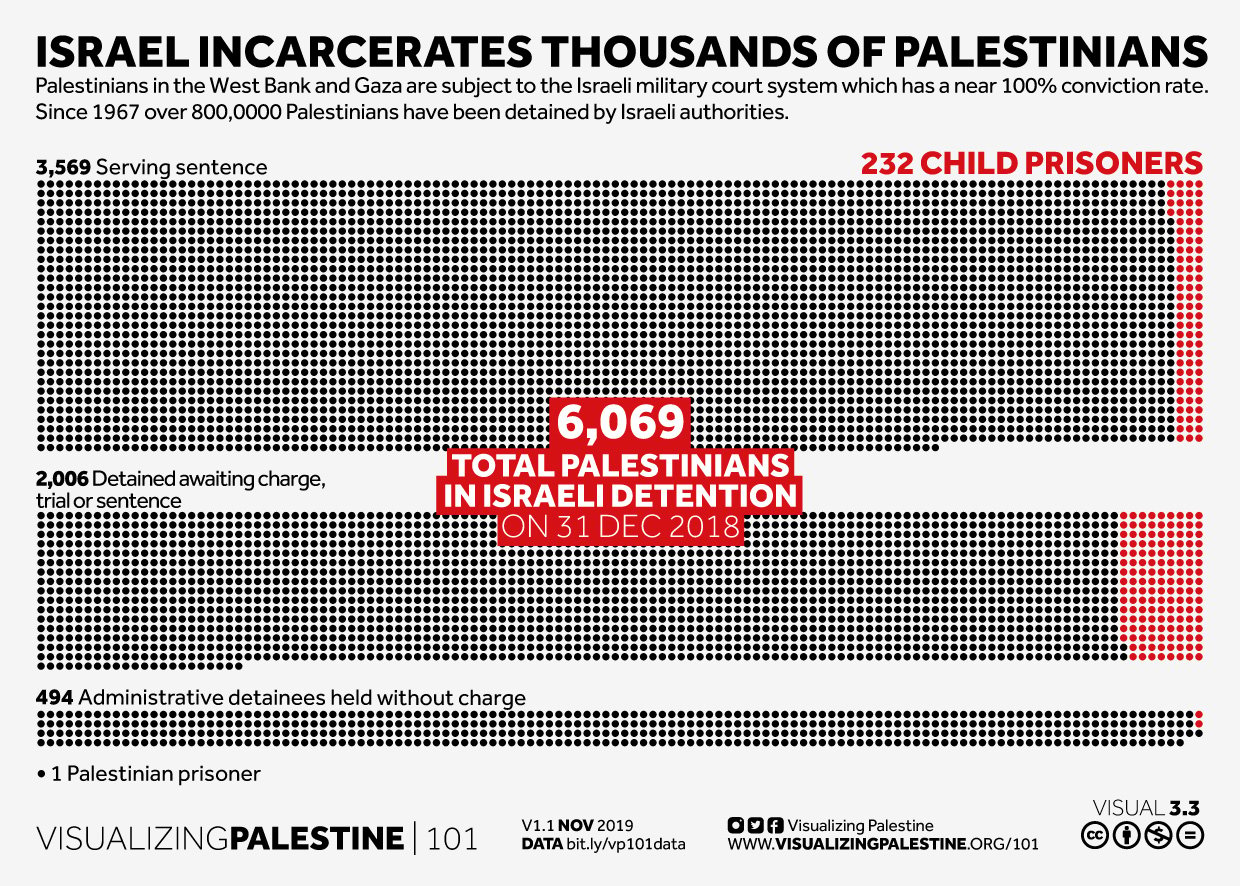
This isnt about the hostages to the Israeli Government, this is Israel engaging in Genocide to eradicate and forcibly displace the Palestinian people. Gaza has never stopped being under Israeli occupation since 1967. Hamas only exists because of the Apartheid Occupation of Israel and the daily violence that has subjected Palestinians to for generations. Israel has always been the obstacle for peace, and has been the one preventing a ceasefire.
Human Shields
Hamas:
Intentionally utilizing the presence of civilians or other protected persons to render certain areas immune from military attack is prohibited under international law. Amnesty International was not able to establish whether or not the fighters’ presence in the camps was intended to shield themselves from military attacks. However, under international humanitarian law, even if one party uses “human shields”, or is otherwise unlawfully endangering civilians, this does not absolve the opposing party from complying with its obligations to distinguish between military objectives and civilians or civilian objects, to refrain from carrying out indiscriminate or disproportionate attacks, and to take all feasible precautions to spare civilians and civilian objects.
Israel:
Additionally, there is extensive independent verification of Israel using Palestinians as Human Shields:
-
Including Children (2013 Report)
-
Israel “Systematically” Uses Gaza Children as Human Shields, Rights Group Finds 2024
-
Breaking The Silence - Testimonies from IDF Veterans
Deliberate Attacks on Civilians
Israel deliberately targets civilian areas. From in general with the Dahiya Doctrine to multiple systems deployed in Gaza to do so:
-
The Dahiya Doctrine & Israel’s Use of Disproportionate Force
-
‘A mass assassination factory’: Inside Israel’s calculated bombing of Gaza
Israel also targets Israeli Soldiers and Civilians to prevent them being leveraged as hostages, known as the Hannibal Directive. Which was also used on Oct 7th.

 61·2 days ago
61·2 days agoI’m laughing at the patently absurd and ridiculous conspiracy theory that the local Palestinian gangs lead by the Palestinian Abu Shabab are “backed by Israel”. A claim that has literally zero evidence or basis in fact behind it.
There is evidence
An internal UN memo obtained by the Washington Post concluded in October that the gangs “may be benefiting from a passive if not active benevolence” or “protection” from the Israeli army.
The memo said that one gang leader established a “military like compound” in an area “restricted, controlled and patrolled" by the Israeli army.
With the collapse of civil order due to Israel’s targeting and killing of members of Gaza’s police force, few people are left to guard humanitarian aid convoys.
Aid organisations say Israel has denied most of their requests for better measures to ensure the safety of convoys. As the occupying force, Israel is legally responsible for ensuring aid supplies to civilian populations
Only 57 trucks a day were allowed to cross into Gaza in October, far lower than the 350 the US had requested, and the 600 a day aid agencies say are required to meet basic needs. Meanwhile, food prices have skyrocketed.
Gaza police battle gang members accused of stealing humanitarian aid
This isn’t about me, other than the fact that this is about Palestinian thugs stealing the humanitarian aid that my taxes have helped pay for from other Palestinians
This entire famine created by Israel is deliberate and intentional. If you’re worried taxes, you should be focused on the magnitudes more, over 17 billion, going to the weapons being used to facilitate this genocide. All this chaos only goes to show how woefully inadequate the humanitarian aid has been and how much more is needed.

 112·2 days ago
112·2 days agoThe slogan From the River to the Sea is about Palestinian liberation that started in the 60s by the PLO for a democratic secular state, not Genocide. The Syrian leader Hafez al-Assad in 1966 maybe, but he’s not Palestinian.

 71·2 days ago
71·2 days agoHow do you read that 2 million people are being deliberately forcibly displayed, starved, and targeted; and respond with a laughing emoji. It’s not surprising that everybody in Gaza is desperate for food and aid when they’ve been starved and bombed nonstop for an entire year. How do you read that and laugh?

 7·2 days ago
7·2 days agoFrom the Haaretz article:
A school in northern Gaza burned down on Monday, hours after humanitarian aid trucks had arrived to it, according to photos and accounts by locals. Residents of the area said Israeli soldiers had set the fire that consumed the school.
A video seen on social media on Sunday, taken by an IDF soldier, showed two Israeli armored vehicles leaving the school surroundings as it was engulfed in flames
Staff from the UN World Food Program, which sent the aid, as well as other international sources, said Gazans did not even have time to collect the aid. They said the military launched an attack in the area and soldiers had surrounded the building before the food was distributed.
The convoy, consisting of two trucks and a water tanker, was the first to be approved by the military to enter northern Gaza after a month and a half of siege. The decision followed international pressure over the failure to deliver aid to Gazans.
Witnesses said soldiers forced civilians away from the area, preventing them from collecting the aid, which was later destroyed by the fire. Reports also said civilians had been killed at the site. The soldiers involved belonged to the Rotem Battalion in the Givati Brigade, the reports said.
Other footage was posted on Thursday showing fires at schools in northern Gaza. A video from the Jabalya refugee camp showed a soldier standing in the yard of a burning school. Another video showed a large blaze in the Salah al-Din School in Gaza City, which had been serving as a shelter for refugees.

 283·2 days ago
283·2 days agoHamas proposed a full prisoner swap as early as Oct 8th, and agreed to the US proposed UN Permanent Ceasefire Resolution. Additionally, Hamas has already agreed to no longer govern the Gaza Strip, as long as Palestinians receive liberation and a unified government can take place.
This isnt about the hostages, this is Israel engaging in Genocide to eradicate and forcibly displace the Palestinian people. Gaza has never stopped being under Israeli occupation since 1967. Hamas only exists because of the Apartheid Occupation of Israel and the daily violence that has subjected Palestinians to for generations. Israel has always been the obstacle for peace, and has been the one preventing a ceasefire.
De-development via the Gaza Occupation
Between July 1971 and February 1972, Sharon enjoyed considerable success. During this time, the entire Strip (apart from the Rafah area) was sealed off by a ring of security fences 53 miles in length, with few entrypoints. Today, their effects live on: there are only three points of entry to Gaza—Erez, Nahal Oz, and Rafah.
Perhaps the most dramatic and painful aspect of Sharon’s campaign was the widening of roads in the refugee camps to facilitate military access. Israel built nearly 200 miles of security roads and destroyed thousands of refugee dwellings as part of the widening process.’ In August 1971, for example, the Israeli army destroyed 7,729 rooms (approximately 2,000 houses) in three vola- tile camps, displacing 15,855 refugees: 7,217 from Jabalya, 4,836 from Shati, and 3,802 from Rafah.
- Page 105
Through 1993 Israel imposed a one-way system of tariffs and duties on the importation of goods through its borders; leaving Israel for Gaza, however, no tariffs or other regulations applied. Thus, for Israeli exports to Gaza, the Strip was treated as part of Israel; but for Gazan exports to Israel, the Strip was treated as a foreign entity subject to various “non-tariff barriers.” This placed Israel at a distinct advantage for trading and limited Gaza’s access to Israeli and foreign markets. Gazans had no recourse against such policies, being totally unable to protect themselves with tariffs or exchange rate controls. Thus, they had to pay more for highly protected Israeli products than they would if they had some control over their own economy. Such policies deprived the occupied territories of significant customs revenue, estimated at $118-$176 million in 1986.
- page 240
In a report released in May 2015, the World Bank revealed that as a result of Israel’s blockade and OPE, Gaza’s manufacturing sector shrank by as much as 60% over eight years while real per capita income is 31 percent lower than it was 20 years ago. The report also stated that the blockade alone is responsible for a 50% decrease in Gaza’s GDP since 2007. Furthermore, OPE (combined with the tunnel closure) exacerbated an already grave situation by reducing Gaza’s economy by an additional $460 million.
-
Page 402
-
The Gaza Strip: The Political Economy of De-Development - Third Edition by Sara M. Roy
Blockade, including Aid
Hamas began twenty years into the occupation during the first Intifada, with the goal of ending the occupation. Collective punishment has been a deliberate Israeli tactic for decades with the Dahiya doctrine. Violence such as suicide bombings and rockets escalated in response to Israeli enforcement of the occupation and apartheid.
After the ‘disengagement’ in 2007, this turned into a full blockade; where Israel has had control over the airspace, borders, and sea. Under the guise of ‘dual-use’ Israel has restricted food, allocating a minimum supply leading to over half of Gaza being food insecure; construction materials, medical supplies, and other basic necessities have also been restricted.
The blockade and Israel’s repeated military offensives have had a heavy toll on Gaza’s essential infrastructure and further debilitated its health system and economy, leaving the area in a state of perpetual humanitarian crisis. Indeed, Israel’s collective punishment of Gaza’s civilian population, the majority of whom are children, has created conditions inimical to human life due to shortages of housing, potable water and electricity, and lack of access to essential medicines and medical care, food, educational equipment and building materials.
- Amnesty International Report pg 26-27
Peace Process and Solution
Both Hamas and Fatah have agreed to a Two-State solution based on the 1967 borders for decades. Oslo and Camp David were used by Israel to continue settlements in the West Bank and maintain an Apartheid, while preventing any actual Two-State solution
How Avi Shlaim moved from two-state solution to one-state solution
‘One state is a game changer’: A conversation with Ilan Pappe
Human Shields
Hamas:
Intentionally utilizing the presence of civilians or other protected persons to render certain areas immune from military attack is prohibited under international law. Amnesty International was not able to establish whether or not the fighters’ presence in the camps was intended to shield themselves from military attacks. However, under international humanitarian law, even if one party uses “human shields”, or is otherwise unlawfully endangering civilians, this does not absolve the opposing party from complying with its obligations to distinguish between military objectives and civilians or civilian objects, to refrain from carrying out indiscriminate or disproportionate attacks, and to take all feasible precautions to spare civilians and civilian objects.
Israel:
Additionally, there is extensive independent verification of Israel using Palestinians as Human Shields:
-
Including Children (2013 Report)
-
Israel “Systematically” Uses Gaza Children as Human Shields, Rights Group Finds 2024
-
Breaking The Silence - Testimonies from IDF Veterans
Deliberate Attacks on Civilians
Israel deliberately targets civilian areas. From in general with the Dahiya Doctrine to multiple systems deployed in Gaza to do so:
-
The Dahiya Doctrine & Israel’s Use of Disproportionate Force
-
‘A mass assassination factory’: Inside Israel’s calculated bombing of Gaza
Israel also targets Israeli Soldiers and Civilians to prevent them being leveraged as hostages, known as the Hannibal Directive. Which was also used on Oct 7th.

 5·2 days ago
5·2 days ago6th paragraph
Behind the scenes, officials were exasperated. “It’s absolutely insane,” said one Pentagon official who spoke on the condition of anonymity because he was not authorized to speak with the press on the matter. “I never thought I’d see the day when this was a ‘serious’ — put that in scare quotes — policy.” He said that the legal and logistical hurdles would be immense, and the proposal was “unrealistic and unserious.”

 143·2 days ago
143·2 days agoIsraeli soldiers have also set a school on fire right after it got aid to prevent the starving population from getting any aid

 2·3 days ago
2·3 days agoGaza has never stopped being under Israeli occupation since 1967. Hamas only exists because of the Apartheid Occupation of Israel and the daily violence that has subjected Palestinians to for generations. Israel has always been the obstacle for peace, and has been the one preventing a ceasefire.
De-development via the Gaza Occupation
Between July 1971 and February 1972, Sharon enjoyed considerable success. During this time, the entire Strip (apart from the Rafah area) was sealed off by a ring of security fences 53 miles in length, with few entrypoints. Today, their effects live on: there are only three points of entry to Gaza—Erez, Nahal Oz, and Rafah.
Perhaps the most dramatic and painful aspect of Sharon’s campaign was the widening of roads in the refugee camps to facilitate military access. Israel built nearly 200 miles of security roads and destroyed thousands of refugee dwellings as part of the widening process.’ In August 1971, for example, the Israeli army destroyed 7,729 rooms (approximately 2,000 houses) in three vola- tile camps, displacing 15,855 refugees: 7,217 from Jabalya, 4,836 from Shati, and 3,802 from Rafah.
- Page 105
Through 1993 Israel imposed a one-way system of tariffs and duties on the importation of goods through its borders; leaving Israel for Gaza, however, no tariffs or other regulations applied. Thus, for Israeli exports to Gaza, the Strip was treated as part of Israel; but for Gazan exports to Israel, the Strip was treated as a foreign entity subject to various “non-tariff barriers.” This placed Israel at a distinct advantage for trading and limited Gaza’s access to Israeli and foreign markets. Gazans had no recourse against such policies, being totally unable to protect themselves with tariffs or exchange rate controls. Thus, they had to pay more for highly protected Israeli products than they would if they had some control over their own economy. Such policies deprived the occupied territories of significant customs revenue, estimated at $118-$176 million in 1986.
- page 240
In a report released in May 2015, the World Bank revealed that as a result of Israel’s blockade and OPE, Gaza’s manufacturing sector shrank by as much as 60% over eight years while real per capita income is 31 percent lower than it was 20 years ago. The report also stated that the blockade alone is responsible for a 50% decrease in Gaza’s GDP since 2007. Furthermore, OPE (combined with the tunnel closure) exacerbated an already grave situation by reducing Gaza’s economy by an additional $460 million.
-
Page 402
-
The Gaza Strip: The Political Economy of De-Development - Third Edition by Sara M. Roy
Blockade, including Aid
Hamas began twenty years into the occupation during the first Intifada, with the goal of ending the occupation. Collective punishment has been a deliberate Israeli tactic for decades with the Dahiya doctrine. Violence such as suicide bombings and rockets escalated in response to Israeli enforcement of the occupation and apartheid.
After the ‘disengagement’ in 2007, this turned into a full blockade; where Israel has had control over the airspace, borders, and sea. Under the guise of ‘dual-use’ Israel has restricted food, allocating a minimum supply leading to over half of Gaza being food insecure; construction materials, medical supplies, and other basic necessities have also been restricted.
The blockade and Israel’s repeated military offensives have had a heavy toll on Gaza’s essential infrastructure and further debilitated its health system and economy, leaving the area in a state of perpetual humanitarian crisis. Indeed, Israel’s collective punishment of Gaza’s civilian population, the majority of whom are children, has created conditions inimical to human life due to shortages of housing, potable water and electricity, and lack of access to essential medicines and medical care, food, educational equipment and building materials.
- Amnesty International Report pg 26-27
Peace Process and Solution
Both Hamas and Fatah have agreed to a Two-State solution based on the 1967 borders for decades. Oslo and Camp David were used by Israel to continue settlements in the West Bank and maintain an Apartheid, while preventing any actual Two-State solution
How Avi Shlaim moved from two-state solution to one-state solution
‘One state is a game changer’: A conversation with Ilan Pappe
One State Solution, Foreign Affairs
Hamas proposed a full prisoner swap as early as Oct 8th, and agreed to the US proposed UN Permanent Ceasefire Resolution. Additionally, Hamas has already agreed to no longer govern the Gaza Strip, as long as Palestinians receive liberation and a unified government can take place.
Human Shields
Hamas:
Intentionally utilizing the presence of civilians or other protected persons to render certain areas immune from military attack is prohibited under international law. Amnesty International was not able to establish whether or not the fighters’ presence in the camps was intended to shield themselves from military attacks. However, under international humanitarian law, even if one party uses “human shields”, or is otherwise unlawfully endangering civilians, this does not absolve the opposing party from complying with its obligations to distinguish between military objectives and civilians or civilian objects, to refrain from carrying out indiscriminate or disproportionate attacks, and to take all feasible precautions to spare civilians and civilian objects.
Israel:
Additionally, there is extensive independent verification of Israel using Palestinians as Human Shields:
-
Including Children (2013 Report)
-
Israel “Systematically” Uses Gaza Children as Human Shields, Rights Group Finds 2024
-
Breaking The Silence - Testimonies from IDF Veterans
Deliberate Attacks on Civilians
Israel deliberately targets civilian areas. From in general with the Dahiya Doctrine to multiple systems deployed in Gaza to do so:
-
The Dahiya Doctrine & Israel’s Use of Disproportionate Force
-
‘A mass assassination factory’: Inside Israel’s calculated bombing of Gaza
Israel also targets Israeli Soldiers and Civilians to prevent them being leveraged as hostages, known as the Hannibal Directive. Which was also used on Oct 7th.

 32·4 days ago
32·4 days agoZionism is a Settler Colonialist Ideology that planned the ethnic cleansing of Palestine in 1947
Partition
The Zionist position changed in 1928, when the pragmatic Palestinian leaders agreed to the principle of parity in a rare moment in which clannish and religious differences were overcome for the sake of consensus. The Palestinian leaders feared that without parity the Zionists would gain control of the political system. The unexpected Palestinian agreement threw the Zionist leaders into temporary confusion. When they recovered, they sent a refusal to the British, but at the same time offered an alternative solution: the partitioning of Palestine into two political units.
- Pg 132 of Ilan Pappe - A History of Modern Palestine
On 31 August 1947, UNSCOP presented its recommendations to the UN General Assembly. Three of its members were allowed to put forward an alternative recommendation. The majority report advocated the partition of Palestine into two states, with an economic union. The designated Jewish state was to have most of the coastal area, western Galilee, and the Negev, and the rest was to become the Palestinian state. The minority report proposed a unitary state in Palestine based on the principle of democracy. It took considerable American Jewish lobbying and American diplomatic pressure, as well as a powerful speech by the Russian ambassador to the UN, to gain the necessary two-thirds majority in the Assembly for partition. Even though hardly any Palestinian or Arab diplomat made an effort to promote the alternative scheme, it won an equal number of supporters and detractors, showing that a considerable number of member states realized that imposing partition amounted to supporting one side and opposing the other.
- Pg 181 of Ilan Pappe - A History of Modern Palestine
Ethnic Cleansing and Settler Colonialism
Israel justifies the settlements and military bases in the West Bank in the name of Security. However, the reality of the settlements on-the-ground has been the cause of violent resistance and a significant obstacle to peace, as it has been for decades.
This type of settlement, where the native population gets ‘Transferred’ to make room for the settlers, is a long standing practice.
- The Transfer Committee, and the JNF Ethnic Cleansing, which led to Forced Displacement of 100,000 Palestinians throughout the mandate before the Nakba
The mass ethnic cleansing campaign of 1948:
Further, declassified Israeli documents show that the Occupation of the West Bank and Gaza Strip were deliberately planned before being executed in 1967:
While the peace process was exploited to continue de-facto annexation of the West Bank via Settlements
The settlements are maintained through a violent apartheid that routinely employs violence towards Palestinians and denies human rights like water access, civil rights, etc. This kind of control gives rise to violent resistance to the Apartheid occupation, jeopardizing the safety of Israeli civilians.
Visualizing the Ethnic Cleansing


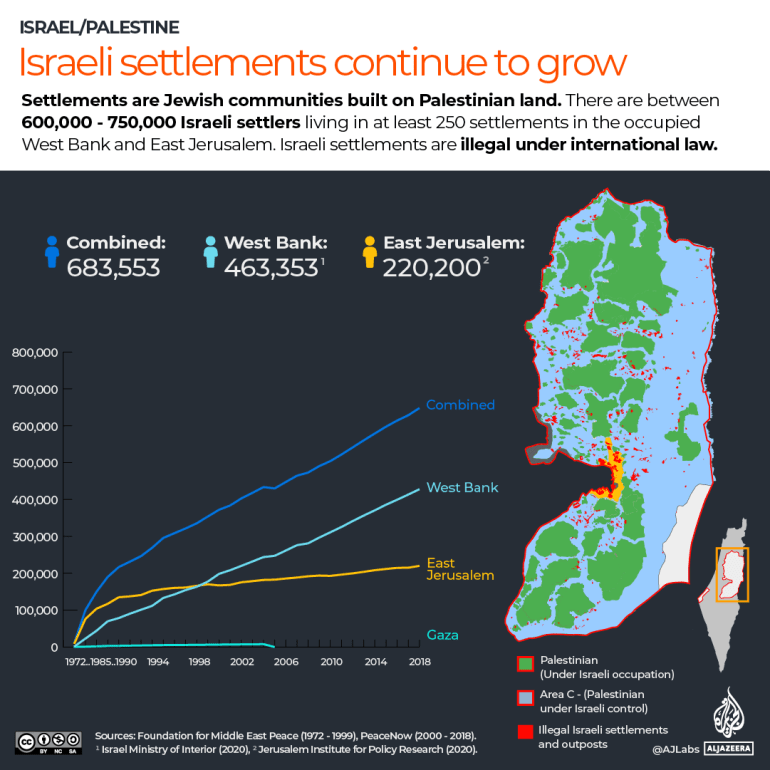
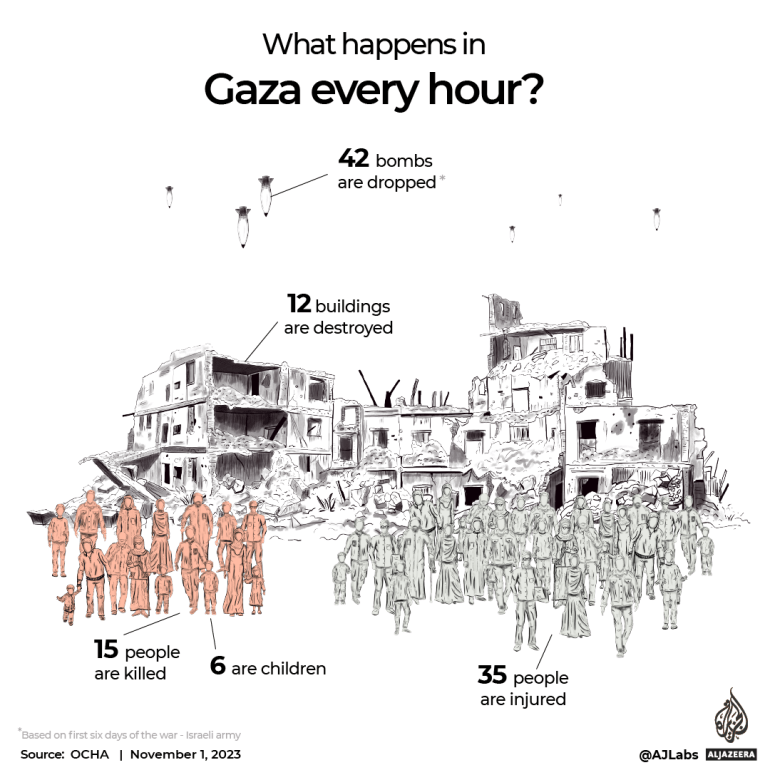

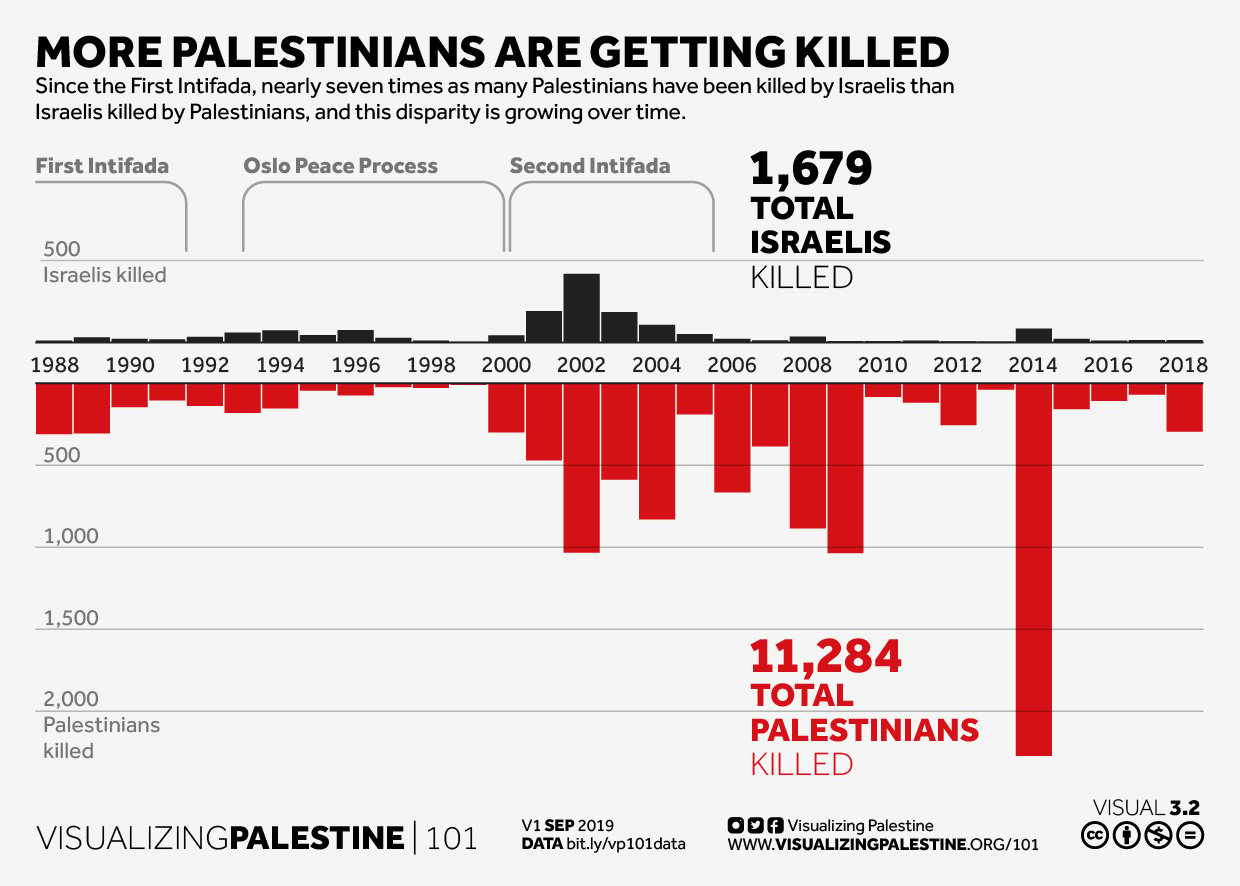
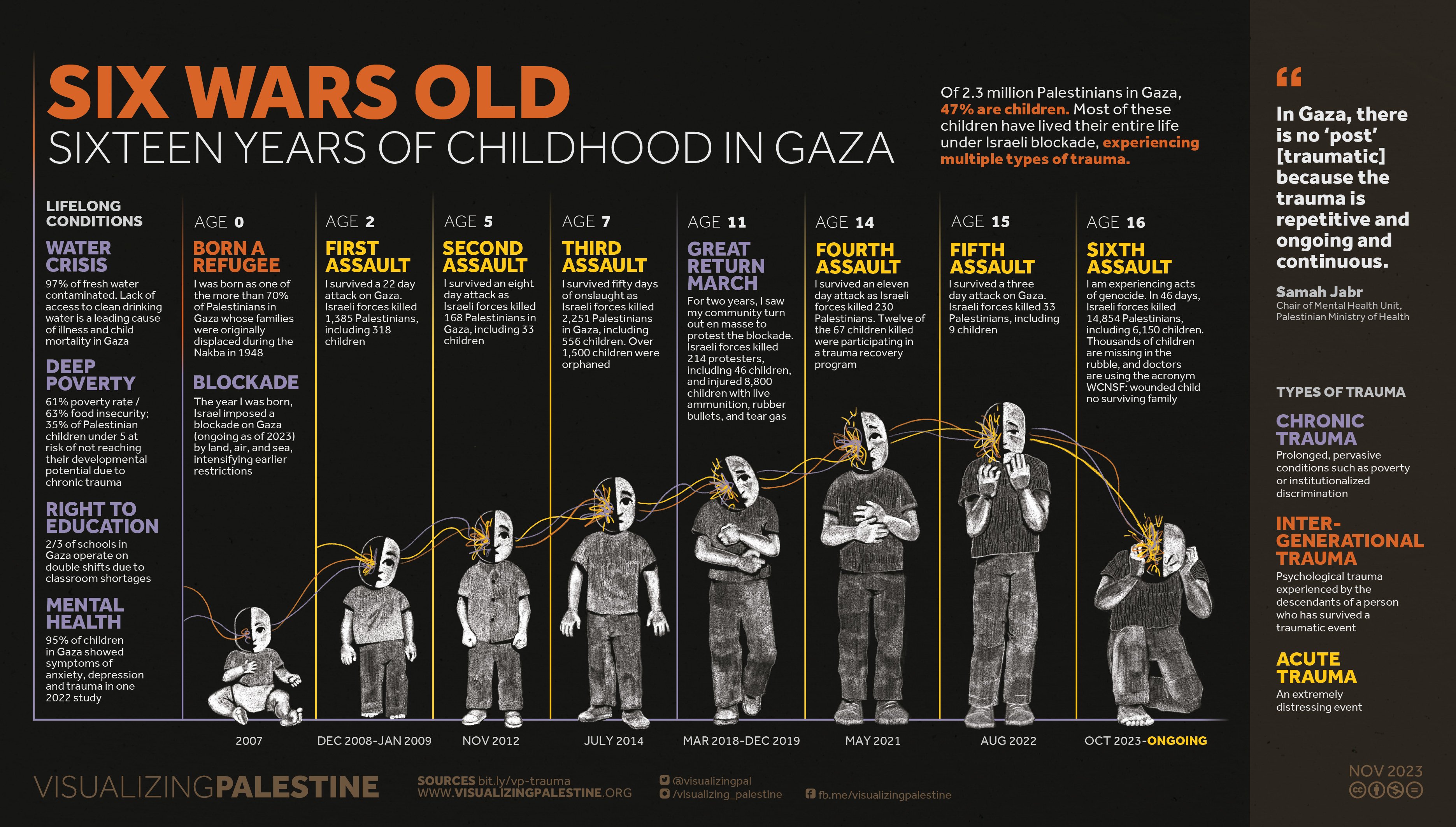
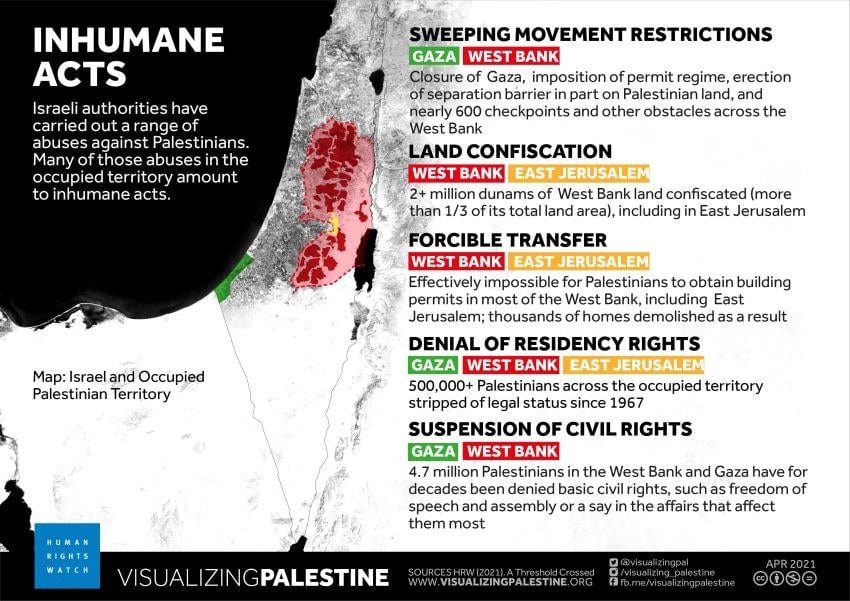
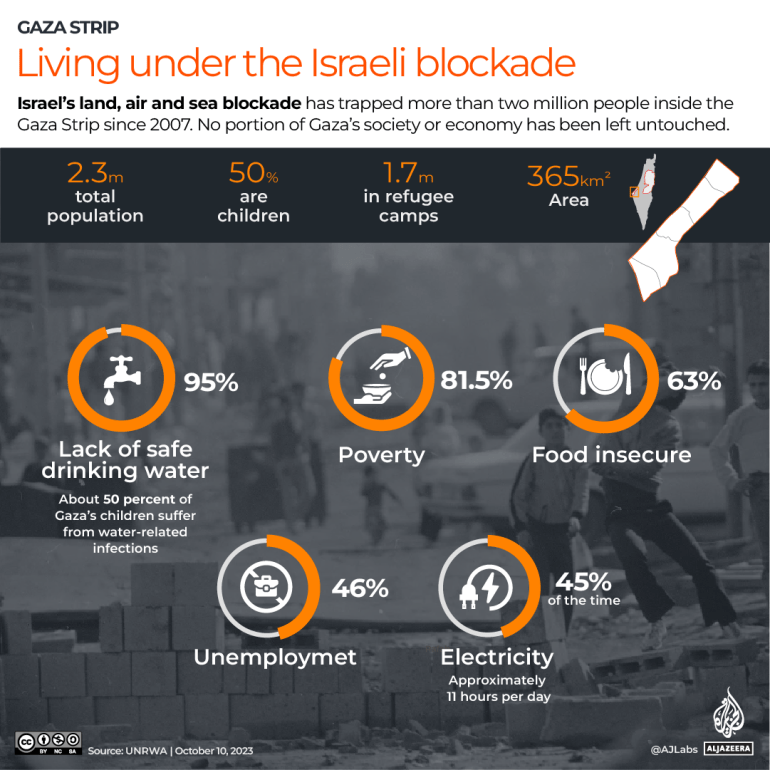
Peace Process and Solution
Both Hamas and Fatah have agreed to a Two-State solution based on the 1967 borders for decades. Oslo and Camp David were used by Israel to continue settlements in the West Bank and maintain an Apartheid, while preventing any actual Two-State solution
How Avi Shlaim moved from two-state solution to one-state solution
‘One state is a game changer’: A conversation with Ilan Pappe
One State Solution, Foreign Affairs
Hamas proposed a full prisoner swap as early as Oct 8th, and agreed to the US proposed UN Permanent Ceasefire Resolution. Additionally, Hamas has already agreed to no longer govern the Gaza Strip, as long as Palestinians receive liberation and a unified government can take place.
Historian Works on the History
-
Palestine: A Four Thousand Year History - Nur Masalha
-
The Concept of Transfer 1882-1948 - Nur Masalha
-
A History of Modern Palestine - Ilan Pappe
-
The Hundred Years’ War on Palestine - Rashid Khalidi
-
The Ethnic Cleansing of Palestine - Ilan Pappe
-
The 1967 Arab-Israeli War: Origins and Consequences - Avi Shlaim
-
The Biggest Prison on Earth: A History of the Occupied Territories - Ilan Pappe
-
The Gaza Strip: The Political Economy of De-development - Sara Roy
-
10 Myths About Israel - Ilan Pappe (summery)

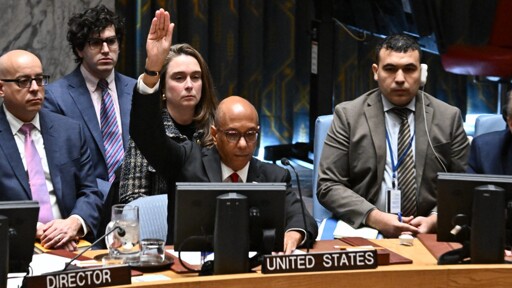
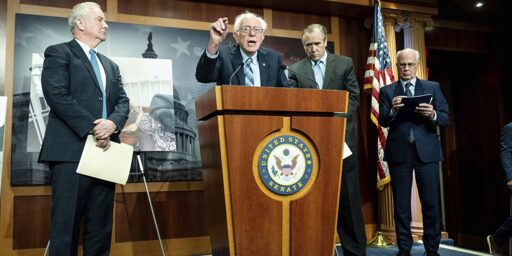
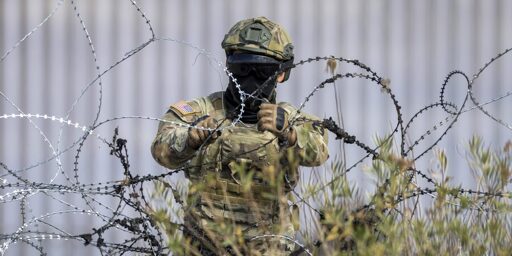
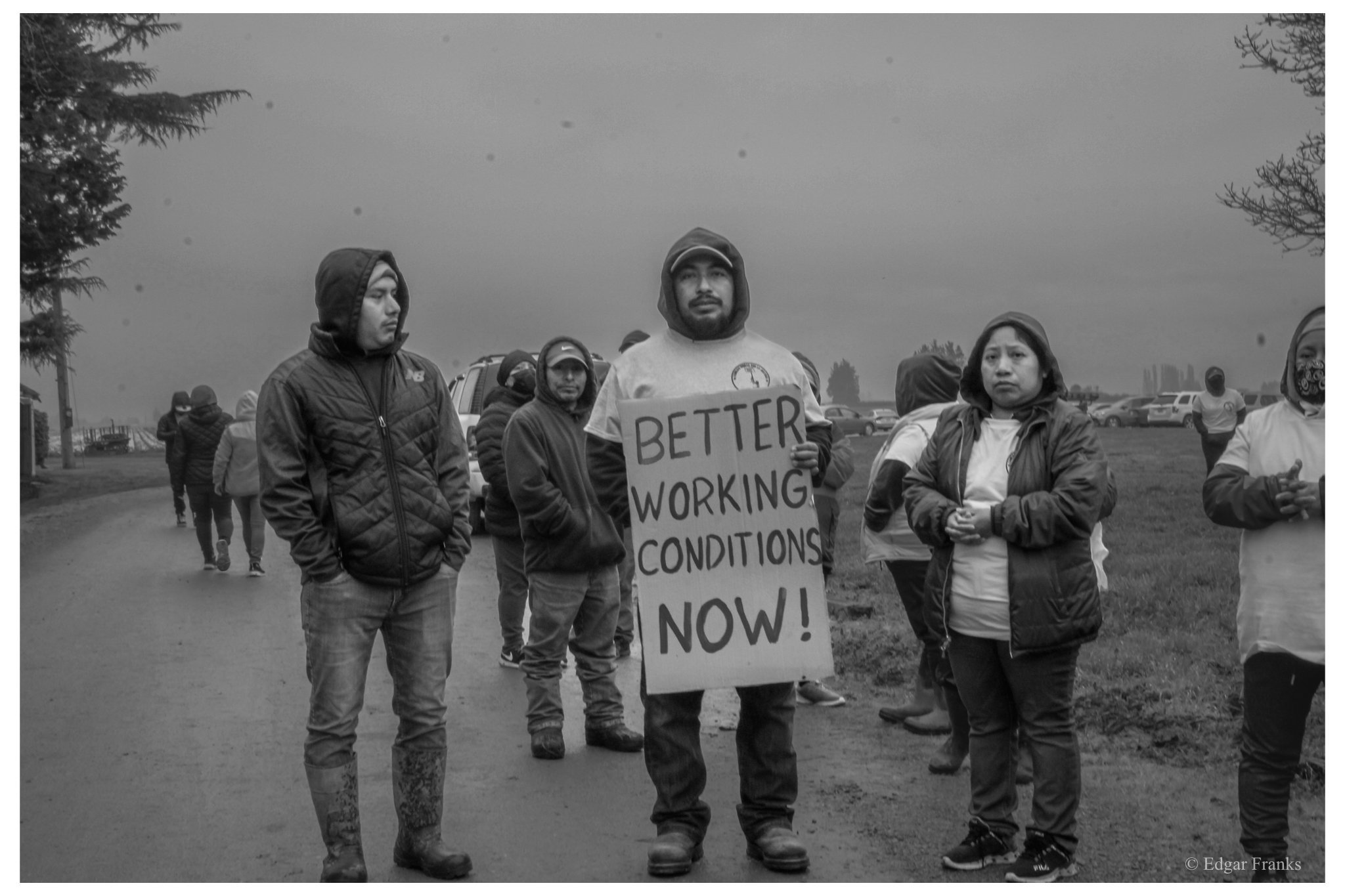

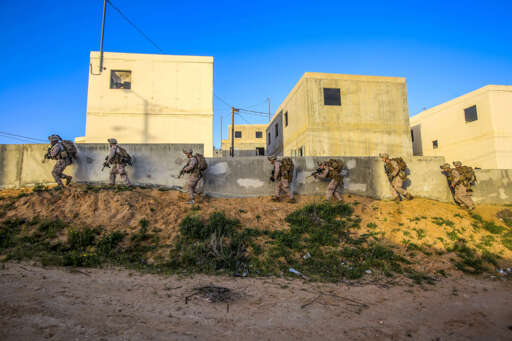
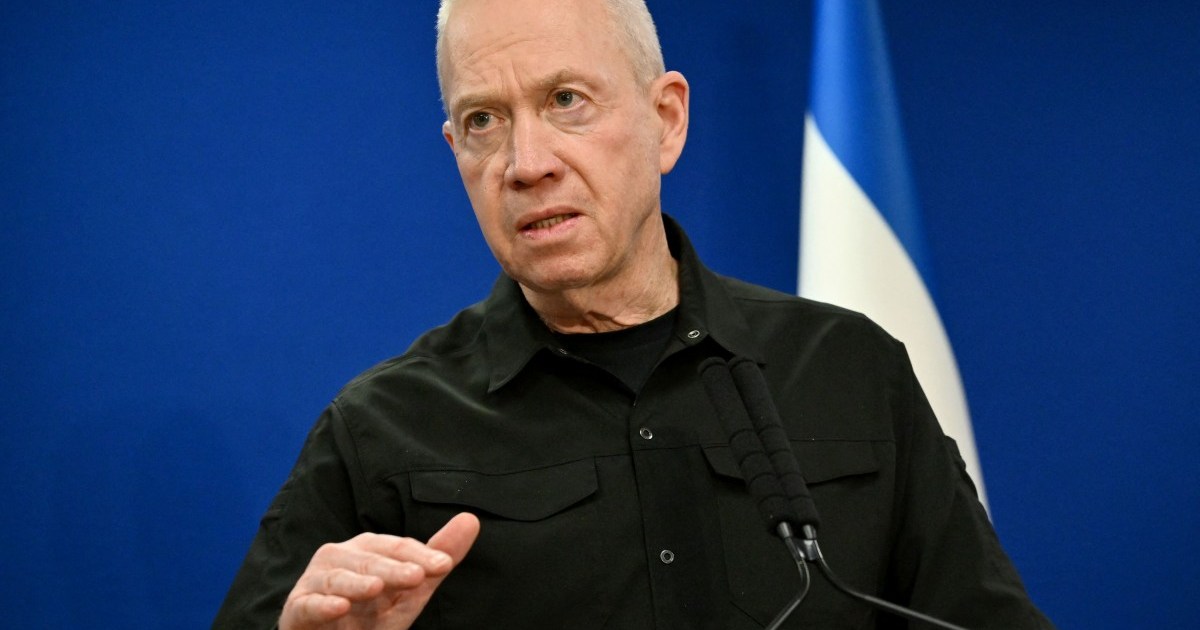
Zionism is a fascist settler colonialist ideology that has always been set on the ethnic cleansing of Palestine. Anti-colonialist resistance for liberation and peace is not equivalent to Colonialist supremacy
Ethnic Cleansing is fundamental to Zionism
Settlements and Occupation
Israel justifies the settlements and military bases in the West Bank in the name of Security. However, the reality of the settlements on-the-ground has been the cause of violent resistance and a significant obstacle to peace, as it has been for decades.
This type of settlement, where the native population gets ‘Transferred’ to make room for the settlers, is a long standing practice.
The mass ethnic cleansing campaign of 1948:
Further, declassified Israeli documents show that the Occupation of the West Bank and Gaza Strip were deliberately planned before being executed in 1967:
While the peace process was exploited to continue de-facto annexation of the West Bank via Settlements
The settlements are maintained through a violent apartheid that routinely employs violence towards Palestinians and denies human rights like water access, civil rights, etc. This kind of control gives rise to violent resistance to the Apartheid occupation, jeopardizing the safety of Israeli civilians.
Apartheid Evidence
Amnesty Report
Human Rights Watch Report
B’TSelem Report with quick Explainer
Visualizing the Ethnic Cleansing
Peace Process and Solution
Both Hamas and Fatah have agreed to a Two-State solution based on the 1967 borders for decades. Oslo and Camp David were used by Israel to continue settlements in the West Bank and maintain an Apartheid, while preventing any actual Two-State solution
How Avi Shlaim moved from two-state solution to one-state solution
‘One state is a game changer’: A conversation with Ilan Pappe
One State Solution, Foreign Affairs
Hamas proposed a full prisoner swap as early as Oct 8th, and agreed to the US proposed UN Permanent Ceasefire Resolution. Additionally, Hamas has already agreed to no longer govern the Gaza Strip, as long as Palestinians receive liberation and a unified government can take place.
Historian Works on the History
Palestine: A Four Thousand Year History - Nur Masalha
The Concept of Transfer 1882-1948 - Nur Masalha
A History of Modern Palestine - Ilan Pappe
The Hundred Years’ War on Palestine - Rashid Khalidi
The Ethnic Cleansing of Palestine - Ilan Pappe
The 1967 Arab-Israeli War: Origins and Consequences - Avi Shlaim
The Biggest Prison on Earth: A History of the Occupied Territories - Ilan Pappe
The Gaza Strip: The Political Economy of De-development - Sara Roy
10 Myths About Israel - Ilan Pappe (summery)